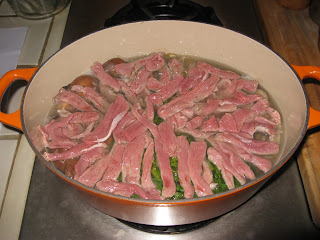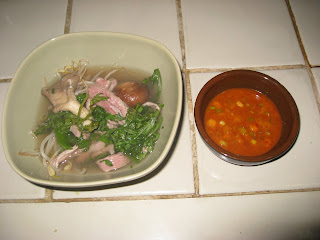The book is exactly what it says: a compendium of recipes for Japanese hot pots, or "nabe." It was written by Chef Tadashi Ono of Matsuri restaurant in New York City, and Harris Salat, author of the Japanese Food Report blog. I tested three recipes: beef shabu shabu, lamb shabu shabu, and a pork and greens hot pot. While I am not a complete stranger to the kitchen, I don't do much in the Japanese idiom, and I'm also not big on strictly following recipes, so this was an interesting experience for me.
The recipes I tested each followed the same basic formula: a broth base, several varieties of vegetables and/or tofu simmered within it, and a last minute addition of thinly sliced protein cooked in the broth, sometimes with a dipping sauce alongside. Simple stuff, really, but that's not to say I didn't learn some valuable things along the way.
First and foremost, dashi. Three ingredients: water, kombu (dried kelp), and katsuobushi (dried, smoked, shaved bonito flakes). A fantastic complexity of flavor: oceanic, vegetal, smoky, even meaty, yet still with a great purity and lightness. And remarkably easy to prepare a serviceable version, though probably something you can spend a lifetime perfecting in order to maximize the umami extraction and balance. Second, "shime." The Japanese custom of adding noodles or rice to the hot pot toward the end of the meal, a great way to soak up the flavors and complete the meal.
These hot pots were easy to prepare, had great depth of flavor, and were simultaneously hearty and healthy.

This is the initial prep for the beef shabu shabu: tofu, napa cabbage, scallions, enoki mushrooms, and portabello mushrooms (couldn't find shiitakes anywhere that day). Underneath are a couple pieces of kombu and a handful of cellophane noodles.

After the vegetables simmer in the water for a few minutes, spinach and thinly sliced beef are added on top; it's "done" as soon as the beef is cooked to your liking. That's a sesame seed dipping sauce on the side. My kids loved this one. I'm sure they would have liked it even more if they had gotten to cook their own beef in the bubbling pot.

Lamb shabu shabu. Similar recipe, with thinly sliced lamb, shiitake and oyster mushrooms, bean sprouts, scallions, and an intriguing green called "shungiku" in Japanese. I turned this up at the Lucky Oriental Mart in South Miami, where they were calling it "tong ho." I've now figured out it's also known as chrysanthemum leaf. You can often find tempura-fried chrysanthemum leaf at Hiro's Yakko-San and it's quite nice.

The dipping sauce for the lamb shabu shabu, primarily flavored with tobanjan (spicy fermented bean paste) and sesame paste, was outrageously good. It was great with the lamb but it was equally great on my finger. Addictive stuff.

This pork and greens hot pot was a little different from the other two recipes I tried, primarily because it started with a dashi broth which was fortified with mirin and usukuchi soy sauce (lighter colored than regular shoyu but possibly saltier). It used napa cabbage, scallions, spinach, shungiku and watercress, thin sliced pork belly (I got some great kurobata pork from Japanese Market), and a dash of white pepper. With the richer broth, no dipping sauce was called for. The real highlight was adding some soft ramen noodles (also in the freezer case at Japanese Market) at the end of the meal, with the starch in the noodles thickening the broth to almost a stew consistency for a hearty, filling finish. This may have been my favorite of the three recipes I tried, because of the more richly flavored broth and, well, pork belly.
The hardest part of these recipes was hunting down some of the ingredients. Japanese Market gets in Japanese vegetables but only once every week or two, though they had all the other dry and prepared ingredients I needed (kombu, katsuobushi, tobanjan, noodles, etc.). Lucky Oriental Mart had a pretty staggering selection of Asian produce, which only required some educated guesswork to make the jump from the Japanese to the Chinese names of things. Otherwise, these dishes were easy to prepare, had good flavors, and with the one-pot cooking, cleanup was easy, which is always nice. For more info on the book, including some videos from the authors, and some pictures that are much nicer than mine, visit the authors' website. Serious Eats is also running a giveaway of 5 cookbooks and featuring several of the recipes this week. I can't find any easy way to steer to all of them at once, so here are the links for dashi and chicken stock, salmon hot pot, sumo wrestler hot pot, and kabocha pumpkin hot pot.



